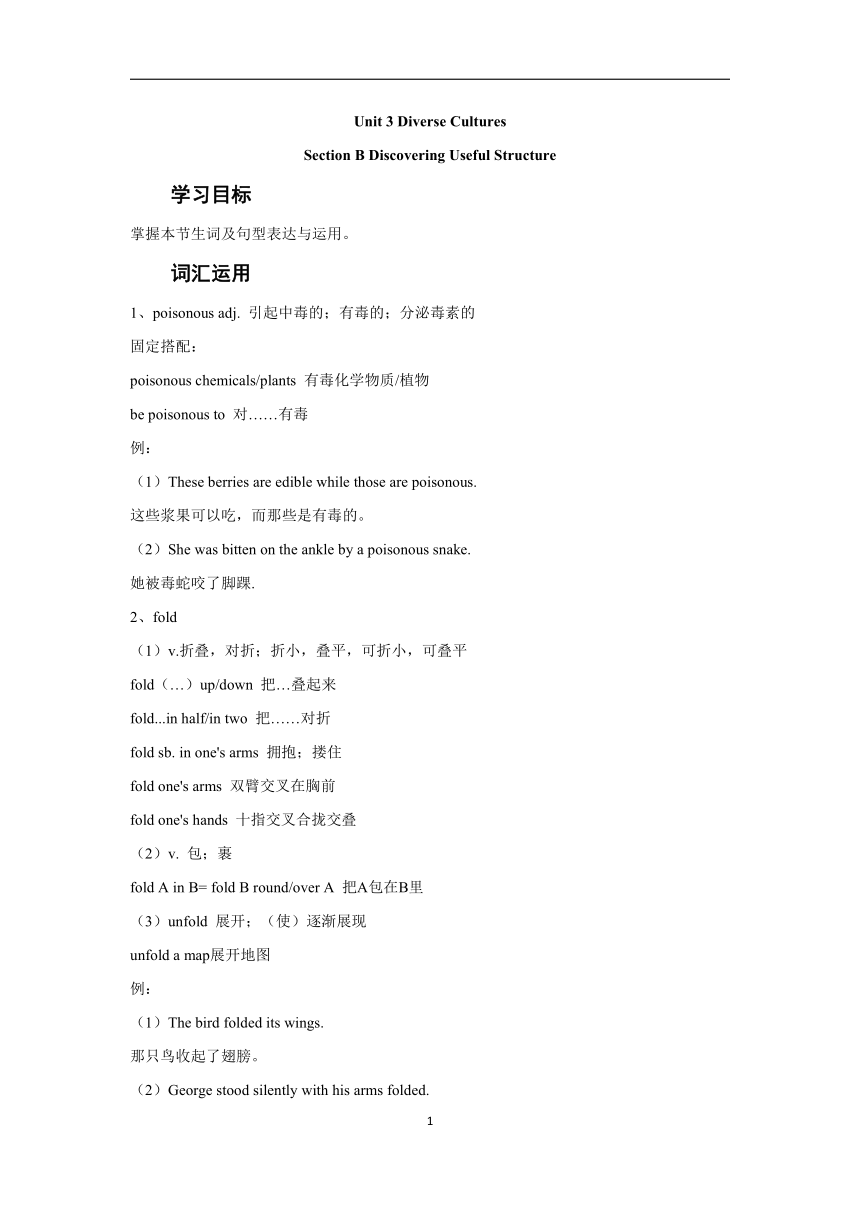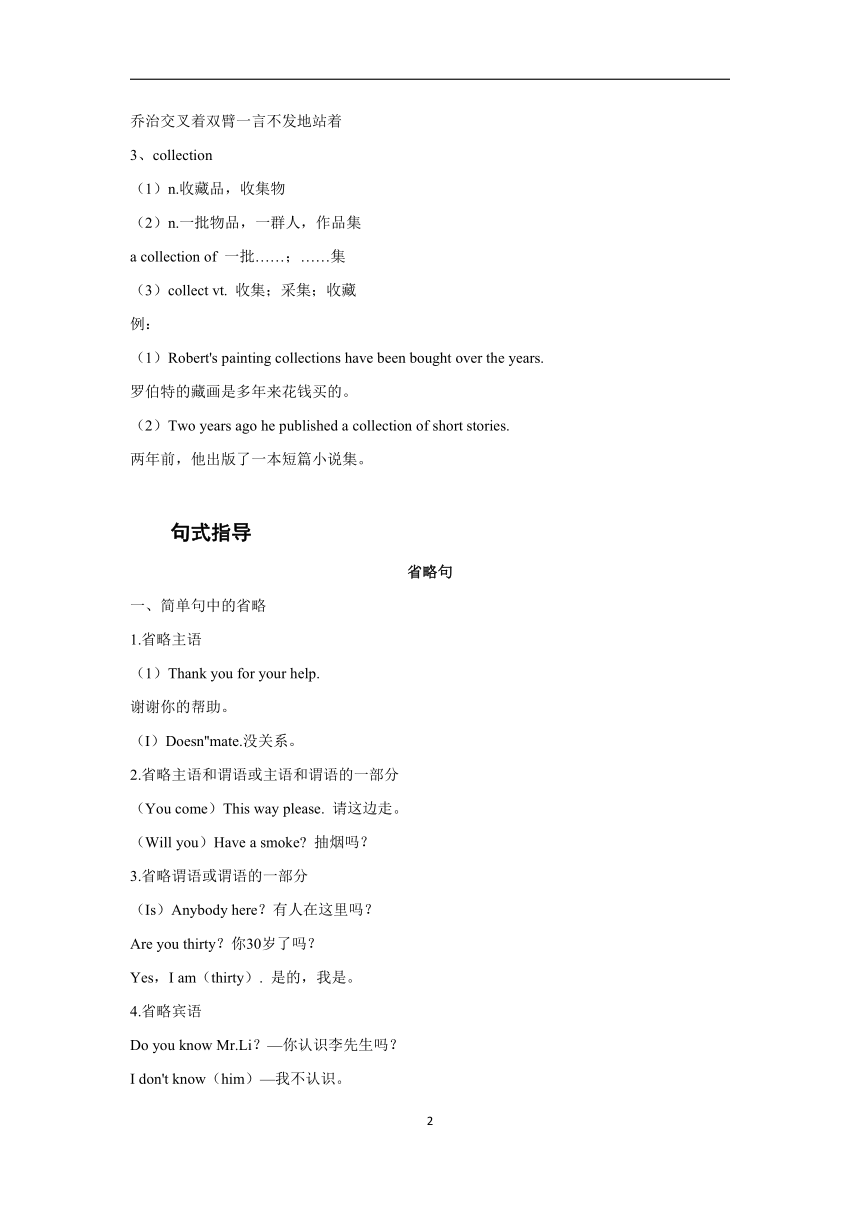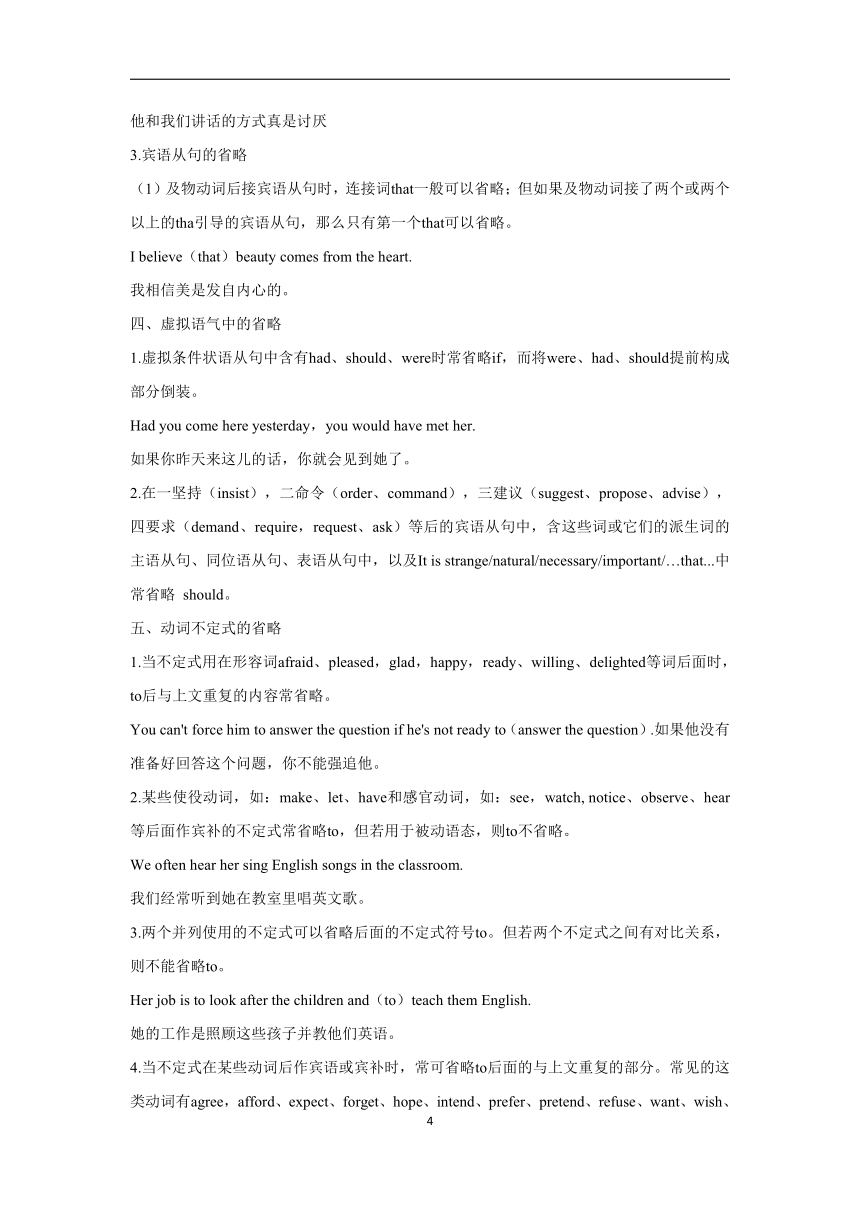人教版(2019)必修第三册 Unit 3 Diverse Cultures Section B Discovering Useful Structures(学案)(含答案)
文档属性
| 名称 | 人教版(2019)必修第三册 Unit 3 Diverse Cultures Section B Discovering Useful Structures(学案)(含答案) |  | |
| 格式 | docx | ||
| 文件大小 | 27.7KB | ||
| 资源类型 | 教案 | ||
| 版本资源 | 人教版(2019) | ||
| 科目 | 英语 | ||
| 更新时间 | 2022-12-08 16:28:05 | ||
图片预览




文档简介
Unit 3 Diverse Cultures
Section B Discovering Useful Structure
学习目标
掌握本节生词及句型表达与运用。
词汇运用
1、poisonous adj. 引起中毒的;有毒的;分泌毒素的
固定搭配:
poisonous chemicals/plants 有毒化学物质/植物
be poisonous to 对……有毒
例:
(1)These berries are edible while those are poisonous.
这些浆果可以吃,而那些是有毒的。
(2)She was bitten on the ankle by a poisonous snake.
她被毒蛇咬了脚踝.
2、fold
(1)v.折叠,对折;折小,叠平,可折小,可叠平
fold(…)up/down 把…叠起来
fold...in half/in two 把……对折
fold sb. in one's arms 拥抱;搂住
fold one's arms 双臂交叉在胸前
fold one's hands 十指交叉合拢交叠
(2)v. 包;裹
fold A in B= fold B round/over A 把A包在B里
(3)unfold 展开;(使)逐渐展现
unfold a map展开地图
例:
(1)The bird folded its wings.
那只鸟收起了翅膀。
(2)George stood silently with his arms folded.
乔治交叉着双臂一言不发地站着
3、collection
(1)n.收藏品,收集物
(2)n.一批物品,一群人,作品集
a collection of 一批……;……集
(3)collect vt. 收集;采集;收藏
例:
(1)Robert's painting collections have been bought over the years.
罗伯特的藏画是多年来花钱买的。
(2)Two years ago he published a collection of short stories.
两年前,他出版了一本短篇小说集。
句式指导
省略句
一、简单句中的省略
1.省略主语
(1)Thank you for your help.
谢谢你的帮助。
(I)Doesn''mate.没关系。
2.省略主语和谓语或主语和谓语的一部分
(You come)This way please. 请这边走。
(Will you)Have a smoke 抽烟吗?
3.省略谓语或谓语的一部分
(Is)Anybody here?有人在这里吗?
Are you thirty?你30岁了吗?
Yes,I am(thirty). 是的,我是。
4.省略宾语
Do you know Mr.Li?—你认识李先生吗?
I don't know(him)—我不认识。
二、并列复合句中的省略
在由and或but等并列连词连接的并列复合句中,常省略一些重复的词或词组。
1.若主语不同,而谓语部分的系动词、助动词或情态动词相同,通常省略后面分句的系动词、助动词或情态动词。
Jack must have been playing football and Mary(must have been)doing her homework.杰克肯定一直在踢足球,玛丽肯定一直在做家庭作业。
2.若主语与谓语动词相同,通常省路后面分句的主谓成分。
His advice made me happy,but (his advice made) Jim angry.
他的建议使我高兴,却使吉姆生气。
3.若主语不同,但主要动词及后续部分相同,通常省略后面分句的主要动词及后续部分。
He has a knowledge of first aid but his friend doesn't(have a knowledge of first aid).
他具备急救知识,但他的朋友不具备。
三、主从复合句中的省略
1.状语从句的省略
(1)在 when,while,if,as if,though,although,until,once,whether...or…,unless,whenever等引导的状语从句中,当从句主语与主句主语相同或从句的主语为it,且从句谓语中含有be动词时,从句中的主语和be动词常被省略。
例:Wood gives off much smoke while(it is)burning.
木头燃烧时产生很多烟。
(2)在than和as引导的比较状语从句中常省略than和a后面的某些成分。
例:
They didn't use more water than( it was) necessary.
他们使用的水没有超出需要量。
2.定语从句的省略
(1)在限制性定语从句中,作宾语的关系代词 whom,which,that可省略(但whom,which紧跟在介词后时不能省略)。
The exact year(which/that )Angela and her family spent together in China was 2008.安杰拉和她的家人一起在中国度过的确切年份是2008年。
(2)way后跟定语从句,关系词在从句中作状语时that/in which可以省略。
The way(in which/that)he speaks to us is really annoying.
他和我们讲话的方式真是讨厌
3.宾语从句的省略
(1)及物动词后接宾语从句时,连接词that一般可以省略;但如果及物动词接了两个或两个以上的tha引导的宾语从句,那么只有第一个that可以省略。
I believe(that)beauty comes from the heart.
我相信美是发自内心的。
四、虚拟语气中的省略
1.虚拟条件状语从句中含有had、should、were时常省略if,而将were、had、should提前构成部分倒装。
Had you come here yesterday,you would have met her.
如果你昨天来这儿的话,你就会见到她了。
2.在一坚持(insist),二命令(order、command),三建议(suggest、propose、advise),四要求(demand、require,request、ask)等后的宾语从句中,含这些词或它们的派生词的主语从句、同位语从句、表语从句中,以及It is strange/natural/necessary/important/…that...中常省略 should。
五、动词不定式的省略
1.当不定式用在形容词afraid、pleased,glad,happy,ready、willing、delighted等词后面时,to后与上文重复的内容常省略。
You can't force him to answer the question if he's not ready to(answer the question).如果他没有准备好回答这个问题,你不能强追他。
2.某些使役动词,如:make、let、have和感官动词,如:see,watch, notice、observe、hear等后面作宾补的不定式常省略to,但若用于被动语态,则to不省略。
We often hear her sing English songs in the classroom.
我们经常听到她在教室里唱英文歌。
3.两个并列使用的不定式可以省略后面的不定式符号to。但若两个不定式之间有对比关系,则不能省略to。
Her job is to look after the children and(to)teach them English.
她的工作是照顾这些孩子并教他们英语。
4.当不定式在某些动词后作宾语或宾补时,常可省略to后面的与上文重复的部分。常见的这类动词有agree,afford、expect、forget、hope、intend、prefer、pretend、refuse、want、wish、like等。
I asked him to see the film,but he didn't want to(see the film).
我叫他去看电影,但他不想去
5.连词but、except连接两个不定式,前有实义动词do的某种形式时,后面的不定式不带to。
I have nothing to do but wait.
除了等我无能为力。
6.当主语部分含有实义动词do的某种形式时,作表语的不定式常省略to。
All you need to do is(to)press the button.
你需要做的就是按那个按钮。
六.介词的省略
1.在一些固定搭配中介词常被省略,如 spend time(in)doing sth;have difficulty/trouble(in)doing sth ;prevent/stop sb.(from) doing sth.
She spends half an hour(in)reading every day.
她每天花半个小时读书。
2.在口语中,星期几之前的on可以省略。
We will visit you(on)Tuesday.
我们星期二去看你。
3.在肯定句中,“for+一段时间或距离”中的for有时被省略。
It has rained(for)a whole day.
雨已经下了一整天了。
练习
1.She had much ________difficulty then, so she took a job to ________her further education in a university.(finance) (所给词的适当形式填空)
2.There are now 700 elderly people looking after hens in 20 care homes in the North East, and the charity has been given __________(finance) support to roll it out countrywide. (所给词的适当形式填空)
3.She gently put the baby down on the bed and then________(unfold) it in a blanket. (所给词的适当形式填空)
4.His ________(poem) was slow in achieving recognition. (所给词的适当形式填空)
5.He was freed from________(finance) dependence on his parents. (所给词的适当形式填空)
6.The ________(finance) markets have given the thumbs up to the new policy. (所给词的适当形式填空)
7.Factories produce a large amount of _________(poison) chemicals, which damage the ecological balance and do great harm to our health. (所给词的适当形式填空)
8.This kind of plant has__________(poison)roots. (所给词的适当形式填空)
9.He was bitten by a__________(poison) snake. (所给词的适当形式填空)
10.His dog had been poisoned __________death, which made him sad. (用适当的词填空)
答案以及解析
1. financial finance
【详解】考查形容词和动词。句意:她当时经济困难,所以她找了一份工作,以资助她在一所大学继续深造。空处应填形容词作定语,修饰名词difficulty,financial财政的,财务的,形容词;结合第二空前的不定式符号to可知,此处是不定式作目的状语,空处应填动词原形,finance提供资金,动词。故填①financial②finance。
2.financial
【详解】考查形容词。句意:目前,英国东北部有700名老人在20家护理院照顾母鸡,该慈善机构得到了资金支持,将这项活动推广到全国各地。名词应由形容词修饰。空后为名词support,所以此处用形容词financial,作定语,故填financial。
3.folded
【详解】考查动词。句意:她轻轻地把婴儿放在床上,然后用毯子把它包起来。表示“包裹”应用动词fold,此处陈述过去发生的事情,使用一般过去时。故填folded。
4.poetry
【详解】考查名词。句意:他的诗很难获得认可。poem为可数名词,指具体的一首诗,而poetry为不可数名词,指诗的总称,此处指的是诗的总称,故填poetry。
5.financial
【详解】考查形容词。句意:他在经济上摆脱了对父母的依赖。修饰名词dependence应用形容词financial,作定语。故填financial。
6.financial
【详解】考查形容词。句意:金融市场对新政策表示赞赏。修饰名词markets用形容词,作定语,故填financial。
7.poisonous
【详解】考查形容词。句意:工厂生产大量的有毒化学物质,破坏了生态平衡,对我们的健康造成了很大的危害。根据句中“damage the ecological balance and do great harm to our health”可知,工厂生产的是有毒化学物质,应填入形容词poisonous作定语修饰名词chemicals,意为“有毒的”。故填poisonous。
8.poisonous
【详解】考查形容词。句意:这种植物的根有毒。分析句子,设空处应该填写形容词作定语。poison为名词,意为“毒药”,其形容词为poisonous。故填poisonous。
9.poisonous
【详解】考查形容词。句意:他被一条毒蛇咬了。修饰snake应用形容词poisonous,意为“有毒的”,作定语。故填poisonous。
10.to
【详解】考查介词。句意:他的狗被毒死了,这使他很伤心。固定搭配be poisoned to death意为“被毒死”,to是介词。故填to。
2
Section B Discovering Useful Structure
学习目标
掌握本节生词及句型表达与运用。
词汇运用
1、poisonous adj. 引起中毒的;有毒的;分泌毒素的
固定搭配:
poisonous chemicals/plants 有毒化学物质/植物
be poisonous to 对……有毒
例:
(1)These berries are edible while those are poisonous.
这些浆果可以吃,而那些是有毒的。
(2)She was bitten on the ankle by a poisonous snake.
她被毒蛇咬了脚踝.
2、fold
(1)v.折叠,对折;折小,叠平,可折小,可叠平
fold(…)up/down 把…叠起来
fold...in half/in two 把……对折
fold sb. in one's arms 拥抱;搂住
fold one's arms 双臂交叉在胸前
fold one's hands 十指交叉合拢交叠
(2)v. 包;裹
fold A in B= fold B round/over A 把A包在B里
(3)unfold 展开;(使)逐渐展现
unfold a map展开地图
例:
(1)The bird folded its wings.
那只鸟收起了翅膀。
(2)George stood silently with his arms folded.
乔治交叉着双臂一言不发地站着
3、collection
(1)n.收藏品,收集物
(2)n.一批物品,一群人,作品集
a collection of 一批……;……集
(3)collect vt. 收集;采集;收藏
例:
(1)Robert's painting collections have been bought over the years.
罗伯特的藏画是多年来花钱买的。
(2)Two years ago he published a collection of short stories.
两年前,他出版了一本短篇小说集。
句式指导
省略句
一、简单句中的省略
1.省略主语
(1)Thank you for your help.
谢谢你的帮助。
(I)Doesn''mate.没关系。
2.省略主语和谓语或主语和谓语的一部分
(You come)This way please. 请这边走。
(Will you)Have a smoke 抽烟吗?
3.省略谓语或谓语的一部分
(Is)Anybody here?有人在这里吗?
Are you thirty?你30岁了吗?
Yes,I am(thirty). 是的,我是。
4.省略宾语
Do you know Mr.Li?—你认识李先生吗?
I don't know(him)—我不认识。
二、并列复合句中的省略
在由and或but等并列连词连接的并列复合句中,常省略一些重复的词或词组。
1.若主语不同,而谓语部分的系动词、助动词或情态动词相同,通常省略后面分句的系动词、助动词或情态动词。
Jack must have been playing football and Mary(must have been)doing her homework.杰克肯定一直在踢足球,玛丽肯定一直在做家庭作业。
2.若主语与谓语动词相同,通常省路后面分句的主谓成分。
His advice made me happy,but (his advice made) Jim angry.
他的建议使我高兴,却使吉姆生气。
3.若主语不同,但主要动词及后续部分相同,通常省略后面分句的主要动词及后续部分。
He has a knowledge of first aid but his friend doesn't(have a knowledge of first aid).
他具备急救知识,但他的朋友不具备。
三、主从复合句中的省略
1.状语从句的省略
(1)在 when,while,if,as if,though,although,until,once,whether...or…,unless,whenever等引导的状语从句中,当从句主语与主句主语相同或从句的主语为it,且从句谓语中含有be动词时,从句中的主语和be动词常被省略。
例:Wood gives off much smoke while(it is)burning.
木头燃烧时产生很多烟。
(2)在than和as引导的比较状语从句中常省略than和a后面的某些成分。
例:
They didn't use more water than( it was) necessary.
他们使用的水没有超出需要量。
2.定语从句的省略
(1)在限制性定语从句中,作宾语的关系代词 whom,which,that可省略(但whom,which紧跟在介词后时不能省略)。
The exact year(which/that )Angela and her family spent together in China was 2008.安杰拉和她的家人一起在中国度过的确切年份是2008年。
(2)way后跟定语从句,关系词在从句中作状语时that/in which可以省略。
The way(in which/that)he speaks to us is really annoying.
他和我们讲话的方式真是讨厌
3.宾语从句的省略
(1)及物动词后接宾语从句时,连接词that一般可以省略;但如果及物动词接了两个或两个以上的tha引导的宾语从句,那么只有第一个that可以省略。
I believe(that)beauty comes from the heart.
我相信美是发自内心的。
四、虚拟语气中的省略
1.虚拟条件状语从句中含有had、should、were时常省略if,而将were、had、should提前构成部分倒装。
Had you come here yesterday,you would have met her.
如果你昨天来这儿的话,你就会见到她了。
2.在一坚持(insist),二命令(order、command),三建议(suggest、propose、advise),四要求(demand、require,request、ask)等后的宾语从句中,含这些词或它们的派生词的主语从句、同位语从句、表语从句中,以及It is strange/natural/necessary/important/…that...中常省略 should。
五、动词不定式的省略
1.当不定式用在形容词afraid、pleased,glad,happy,ready、willing、delighted等词后面时,to后与上文重复的内容常省略。
You can't force him to answer the question if he's not ready to(answer the question).如果他没有准备好回答这个问题,你不能强追他。
2.某些使役动词,如:make、let、have和感官动词,如:see,watch, notice、observe、hear等后面作宾补的不定式常省略to,但若用于被动语态,则to不省略。
We often hear her sing English songs in the classroom.
我们经常听到她在教室里唱英文歌。
3.两个并列使用的不定式可以省略后面的不定式符号to。但若两个不定式之间有对比关系,则不能省略to。
Her job is to look after the children and(to)teach them English.
她的工作是照顾这些孩子并教他们英语。
4.当不定式在某些动词后作宾语或宾补时,常可省略to后面的与上文重复的部分。常见的这类动词有agree,afford、expect、forget、hope、intend、prefer、pretend、refuse、want、wish、like等。
I asked him to see the film,but he didn't want to(see the film).
我叫他去看电影,但他不想去
5.连词but、except连接两个不定式,前有实义动词do的某种形式时,后面的不定式不带to。
I have nothing to do but wait.
除了等我无能为力。
6.当主语部分含有实义动词do的某种形式时,作表语的不定式常省略to。
All you need to do is(to)press the button.
你需要做的就是按那个按钮。
六.介词的省略
1.在一些固定搭配中介词常被省略,如 spend time(in)doing sth;have difficulty/trouble(in)doing sth ;prevent/stop sb.(from) doing sth.
She spends half an hour(in)reading every day.
她每天花半个小时读书。
2.在口语中,星期几之前的on可以省略。
We will visit you(on)Tuesday.
我们星期二去看你。
3.在肯定句中,“for+一段时间或距离”中的for有时被省略。
It has rained(for)a whole day.
雨已经下了一整天了。
练习
1.She had much ________difficulty then, so she took a job to ________her further education in a university.(finance) (所给词的适当形式填空)
2.There are now 700 elderly people looking after hens in 20 care homes in the North East, and the charity has been given __________(finance) support to roll it out countrywide. (所给词的适当形式填空)
3.She gently put the baby down on the bed and then________(unfold) it in a blanket. (所给词的适当形式填空)
4.His ________(poem) was slow in achieving recognition. (所给词的适当形式填空)
5.He was freed from________(finance) dependence on his parents. (所给词的适当形式填空)
6.The ________(finance) markets have given the thumbs up to the new policy. (所给词的适当形式填空)
7.Factories produce a large amount of _________(poison) chemicals, which damage the ecological balance and do great harm to our health. (所给词的适当形式填空)
8.This kind of plant has__________(poison)roots. (所给词的适当形式填空)
9.He was bitten by a__________(poison) snake. (所给词的适当形式填空)
10.His dog had been poisoned __________death, which made him sad. (用适当的词填空)
答案以及解析
1. financial finance
【详解】考查形容词和动词。句意:她当时经济困难,所以她找了一份工作,以资助她在一所大学继续深造。空处应填形容词作定语,修饰名词difficulty,financial财政的,财务的,形容词;结合第二空前的不定式符号to可知,此处是不定式作目的状语,空处应填动词原形,finance提供资金,动词。故填①financial②finance。
2.financial
【详解】考查形容词。句意:目前,英国东北部有700名老人在20家护理院照顾母鸡,该慈善机构得到了资金支持,将这项活动推广到全国各地。名词应由形容词修饰。空后为名词support,所以此处用形容词financial,作定语,故填financial。
3.folded
【详解】考查动词。句意:她轻轻地把婴儿放在床上,然后用毯子把它包起来。表示“包裹”应用动词fold,此处陈述过去发生的事情,使用一般过去时。故填folded。
4.poetry
【详解】考查名词。句意:他的诗很难获得认可。poem为可数名词,指具体的一首诗,而poetry为不可数名词,指诗的总称,此处指的是诗的总称,故填poetry。
5.financial
【详解】考查形容词。句意:他在经济上摆脱了对父母的依赖。修饰名词dependence应用形容词financial,作定语。故填financial。
6.financial
【详解】考查形容词。句意:金融市场对新政策表示赞赏。修饰名词markets用形容词,作定语,故填financial。
7.poisonous
【详解】考查形容词。句意:工厂生产大量的有毒化学物质,破坏了生态平衡,对我们的健康造成了很大的危害。根据句中“damage the ecological balance and do great harm to our health”可知,工厂生产的是有毒化学物质,应填入形容词poisonous作定语修饰名词chemicals,意为“有毒的”。故填poisonous。
8.poisonous
【详解】考查形容词。句意:这种植物的根有毒。分析句子,设空处应该填写形容词作定语。poison为名词,意为“毒药”,其形容词为poisonous。故填poisonous。
9.poisonous
【详解】考查形容词。句意:他被一条毒蛇咬了。修饰snake应用形容词poisonous,意为“有毒的”,作定语。故填poisonous。
10.to
【详解】考查介词。句意:他的狗被毒死了,这使他很伤心。固定搭配be poisoned to death意为“被毒死”,to是介词。故填to。
2
